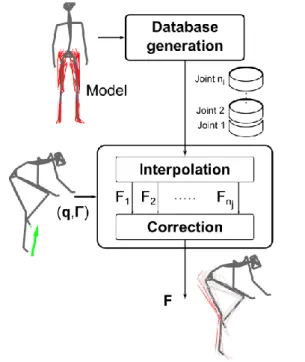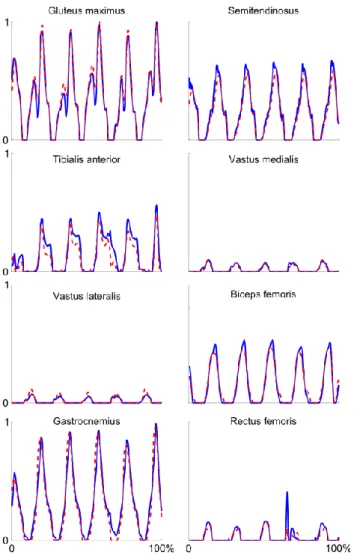HAL Id: hal-01502184
https://hal.inria.fr/hal-01502184
Submitted on 5 Apr 2017HAL is a multi-disciplinary open access archive for the deposit and dissemination of sci-entific research documents, whether they are pub-lished or not. The documents may come from teaching and research institutions in France or abroad, or from public or private research centers.
L’archive ouverte pluridisciplinaire HAL, est destinée au dépôt et à la diffusion de documents scientifiques de niveau recherche, publiés ou non, émanant des établissements d’enseignement et de recherche français ou étrangers, des laboratoires publics ou privés.
MusIC MAKES THE MUSCLES WORK TOGETHER
Antoine Muller, Félix Demore, Charles Pontonnier, Georges Dumont
To cite this version:
Antoine Muller, Félix Demore, Charles Pontonnier, Georges Dumont. MusIC MAKES THE MUS-CLES WORK TOGETHER. XVI International Symposium on Computer Simulation in Biomechanics, Jul 2017, Brisbane, Australia. pp.2. �hal-01502184�
Fig 1: Pipeline of the MusIC method.
XVI International Symposium on Computer Simulation in Biomechanics July 20h – 22nd 2017, Brisbane, Australia
MusIC MAKES THE MUSCLES WORK TOGETHER
Antoine Muller1,2, Félix Demore1, Charles Pontonnier1,2,3 and Georges Dumont1,2
1 École Normale Supérieure de Rennes; 2 IRISA/INRIA, MimeTIC; 3 Écoles de Saint-Cyr Coëtquidan
Email: antoine.muller@irisa.fr
INTRODUCTION
In most musculoskeletal simulation software, the muscle force estimation step is solved thanks to an optimization problem. It consists in minimizing a criterion representing the central nervous system strategy. Despite several improvements, this optimization remains computationally costly. Some authors propose real-time simulations but achieve compromises on model complexity [3] or on the optimization stop criterion [1] to achieve this performance. In this work, we present a fast and quasi-optimal method of muscle forces estimation: the MusIC method (Muscle forces Interpolation and Correction). It is based on precomputed data collected in a database as previously proposed by [4]. Its performance in terms of computation frequency and accuracy is showed on a usually used musculoskeletal leg model thanks to a cycling motion.
METHODS
From joint coordinates q and joint torques Γ, the MusIC method aims at computing a muscle forces vector solution F. It is composed on two steps.
The first one consists in generating a database beforehand by using only the musculoskeletal model (Database generation in Fig. 1). Considering each joint separately, it contains an activation ratio vector, solution of the classical optimization problem for several joint configurations, ranging the physiologically feasible joint space. This vector corresponds to the activation part of each muscle compared to the sum of activations of all these muscles. In the second step, from the current state, we use the database to find a solution of the force sharing problem for each joint (Interpolation in Fig. 1). The activation ratio vector is extracted from the database thanks to a linear interpolation with the current joint configuration. The solutions of each joint are then corrected to compute a muscle forces vector satisfying the global dynamic equilibrium and the
physiological properties (Correction in Fig. 1). For this, a single muscle forces vector is computed thanks to a barycentric interpolation with regard to the different joints. The closest solution of this muscle forces vector which satisfies the global dynamic equilibrium and the physiological properties is then considered as the muscle forces vector solution.
This method was compared to a classical optimization problem solved thanks to a SQP method. For each of them, a 3-order polynomial criterion is applied where each muscle force is normalized by its maximal isometric force. One male participant (184 cm, 70 kg) performed a cycling motion. 47 motion capture markers were placed on standardized anatomical landmarks and captured thanks to a Vicon® motion capture system (125 Hz). Two instrumented pedals (1000 Hz) were used to access external forces applied on each foot. We reconstruct the motion thanks to a whole body model. Musculoskeletal model of the legs is extracted from the work of [2] and is composed of 82 muscles distributed over the two legs.
Fig 2: Muscles forces (each normalized by its
maximum isometric force) on the right leg throughout the motion. The continuous blue line and the dotted red line correspond respectively to results obtained with the classical optimization problem and with the MusIC method.
RESULTS AND DISCUSSION
From muscle forces solution of both methods, we recompute the cost function value throughout the motion. The relative difference between the average values is 2.7%. Thus, the solution suggested by the MusIC method is close to the classical one in terms of optimality. Fig. 2 shows representative examples of muscle forces (each normalized by its maximum isometric force) obtained with both methods. For each of them, periods of activation and non-activation and amplitude of activation are consistent. Considering all muscles, the mean correlation coefficient of the MusIC method results is 0.89(±0.14) compared to the classical optimization problem.
Finally, the computation frequencies are respectively 1.7 Hz and 36 Hz for the classical optimization problem and for the MusIC method. As the database generation is performed beforehand, the computation time of this step is not taken into account.
The results described above show that the MusIC method finds a quasi-optimal solution. Its main benefit is the computation frequency which is approximately twenty times higher. One of the principles of this method is to consider separately the muscles contribution for each joint. However, despite the significant part of poly-articular muscles, the solution seems consistent with the optimal one. Moreover, the use of a linear interpolation seems to filter the muscle forces compared to those obtained with a classical optimization. For example, we can see in Fig. 2 that the rectus femoris force curve obtained with the classical method exhibits an artefact. It comes from a local minimum in the optimization method. As the MusIC method is based on joint configurations which were filtered throughout the motion, this artefact does not appear with this method.
The MusIC method is based on a pre-computed database which depends only on the musculoskeletal model. Thus, it is usable whatever the motion of a subject is and can improve largely the computation time to achieve real time computation. This method could be extended to other cost functions, for example considering the joint reaction forces. Obviously, additional validations have to be performed with other musculoskeletal models to completely validate the MusIC method.
CONCLUSIONS
We presented a fast and quasi-optimal method of muscle forces estimation: the MusIC method, which was partially validated on a musculoskeletal leg model. The solution obtained is close to the optimal one with a particularly low computation time compared to a classical optimization method.
REFERENCES
1. Van den Bogert AJ, et al. Medical & biological engineering & computing 51(10), 1069-1077, 2013.
2. Horsman MK, et al. Clinical biomechanics 22(2), 239-247, 2007.
3. Murai A, et al., Progress in biophysics and molecular biology 103(2), 310-317, 2010. 4. Pontonnier C, et al., Symposium on CMBBE,

